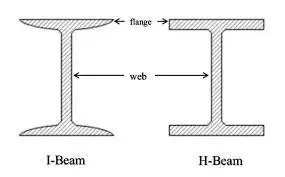Key Differences Between I-Beams and H-Beams in Structural Steel
When it comes to Structural Steel,I-beams (commonly referred to as I-sections or Universal Beams) and H-beams (H-sections or Wide Flange Beams) are two of the most widely used profiles in construction and engineering.

While they may appear similar at first glance, they have distinct differences in design, load-bearing capacity, and application.
1. Shape and Design
-
I-Beam (I-Section):
-
Resembles the letter "I" with a narrow flange (top and bottom horizontal sections) and a taller web (vertical section).
-
Flanges are thinner and tapered toward the edges.
-
Typically lighter in weight compared to H-beams of similar dimensions.
-
-
H-Beam (H-Section):
-
Resembles the letter "H" with wider, parallel flanges and a thicker web.
-
Flanges are of equal width and thickness, providing greater stability.
-
Generally heavier and stronger than I-Beams.
-
2. Load-Bearing Capacity
-
I-Beam: Best suited for unidirectional bending loads (e.g., vertical support in buildings and bridges). Its design makes it efficient for resisting shear forces.
-
H-Beam: Offers superior load distribution due to its wider flanges, making it ideal for heavy-duty applications like columns, platforms, and large-span structures.
3. Manufacturing and Cost
-
I-Beam: Often rolled from a single piece of steel, making production more cost-effective.
-
H-Beam: May require welding or rolling with additional reinforcement, increasing manufacturing complexity and cost.
4. Common Applications
-
I-Beam: Used in residential and commercial construction, bridges, and light industrial frameworks.
-
H-Beam: Preferred for high-stress environments such as skyscrapers, heavy machinery bases, and large-scale infrastructure projects.
Conclusion
Choosing between an I-beam and an H-beam depends on structural requirements, load conditions, and budget. While I-beams are economical for moderate loads,
H-beams provide enhanced strength for heavy-duty construction. Engineers must evaluate factors such as span length, weight distribution, and material efficiency before selecting the appropriate beam type.















